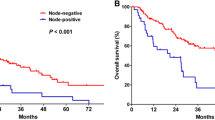Abstract
Background
The optimal treatment strategy for cholangiocarcinoma (CC) after curative resection remains controversial. The aim of this study was to analyze the role of adjuvant therapy in R0-resected distal CC.
Methods
We retrospectively reviewed the medical records of patients who underwent R0 resection for distal CC at six cancer centers in Korea. Adjuvant therapy consisted of chemotherapy (CT), chemoradiotherapy (CRT), or radiotherapy (RT). The outcomes of the study were overall survival (OS) and recurrence-free survival (RFS).
Results
A total of 158 patients were included in the analysis; 47 patients (29.7 %) had lymph node involvement. Fifty-six patients (35.4 %) received adjuvant therapy (CT/CRT/RT: 27/20/9, respectively). Patients with advanced TNM stage (P < 0.001), T3/T4 disease (P = 0.009), positive lymph nodes (LN; P = 0.052), and elevated baseline carbohydrate antigen 19-9 (P = 0.071) were more likely to receive adjuvant therapy. The effect of adjuvant therapy varied according to treatment modality. A multivariable analysis showed a significant improvement in OS after CT [hazard ratio (HR) 0.21, 95 % confidence interval (CI) 0.08–0.53, P = 0.001] and CRT (HR 0.25, 95 % CI 0.08–0.83, P = 0.024). However, RT alone was associated with shorter OS (HR 2.38, P = 0.040), along with T3/T4 disease (HR 2.12, P = 0.012) and positive LN (HR 2.30, P = 0.008). RFS benefited from adjuvant treatment with CT (HR 0.34, P = 0.002) and CRT (HR 0.33, P = 0.004), but not with RT alone (HR 1.42, P = 0.361). In the subset analysis according to LN status, adjuvant therapy not including RT alone was associated with a significant OS and RFS advantage in both LN-negative and LN-positive patients.
Conclusions
Our results show that patients receiving CT or CRT had significant improvements in OS and RFS. In addition, a benefit of adjuvant therapy (except RT alone) was observed even in LN-negative patients.


Similar content being viewed by others
References
Siegel R, Ma J, Zou Z, Jemal A (2014) Cancer statistics, 2014. CA Cancer J Clin 64:9–29
Anderson CD, Pinson CW, Berlin J, Chari RS (2004) Diagnosis and treatment of cholangiocarcinoma. Oncologist 9:43–57
Nakeeb A, Pitt HA (2005) Radiation therapy, chemotherapy and chemoradiation in hilar cholangiocarcinoma. HPB (Oxford) 7:278–282
Williams TM, Majithia L, Wang SJ, Thomas CR Jr (2014) Defining the role of adjuvant therapy: cholangiocarcinoma and gall bladder cancer. Semin Radiat Oncol 24:94–104
Horgan AM, Amir E, Walter T, Knox JJ (2012) Adjuvant therapy in the treatment of biliary tract cancer: a systematic review and meta-analysis. J Clin Oncol 30:1934–1940
Macias RIR (2014) Cholangiocarcinoma: biology, clinical management, and pharmacological perspectives. ISRN Hepatol 2014:13
Kwon HJ, Kim SG, Chun JM, Lee WK, Hwang YJ (2014) Prognostic factors in patients with middle and distal bile duct cancers. World J Gastroenterol 20:6658–6665
DeOliveira ML, Cunningham SC, Cameron JL, Kamangar F, Winter JM, Lillemoe KD, Choti MA, Yeo CJ, Schulick RD (2007) Cholangiocarcinoma: thirty-one-year experience with 564 patients at a single institution. Ann Surg 245:755–762
Heron DE, Stein DE, Eschelman DJ, Topham AK, Waterman FM, Rosato EL, Alden M, Anne PR (2003) Cholangiocarcinoma: the impact of tumor location and treatment strategy on outcome. Am J Clin Oncol 26:422–428
Yoshida T, Matsumoto T, Sasaki A, Morii Y, Aramaki M, Kitano S (2002) Prognostic factors after pancreatoduodenectomy with extended lymphadenectomy for distal bile duct cancer. Arch Surg 137:69–73
Cheng Q, Luo X, Zhang B, Jiang X, Yi B, Wu M (2007) Distal bile duct carcinoma: prognostic factors after curative surgery. A series of 112 cases. Ann Surg Oncol 14:1212–1219
Murakami Y, Uemura K, Hayashidani Y, Sudo T, Hashimoto Y, Ohge H, Sueda T (2007) Prognostic significance of lymph node metastasis and surgical margin status for distal cholangiocarcinoma. J Surg Oncol 95:207–212
Shinohara ET, Mitra N, Guo M, Metz JM (2009) Radiotherapy is associated with improved survival in adjuvant and palliative treatment of extrahepatic cholangiocarcinomas. Int J Radiat Oncol Biol Phys 74:1191–1198
Kiriyama M, Ebata T, Aoba T, Kaneoka Y, Arai T, Shimizu Y, Nagino M (2015) Prognostic impact of lymph node metastasis in distal cholangiocarcinoma. Br J Surg 102:399–406
Kloek JJ, Ten Kate FJ, Busch OR, Gouma DJ, van Gulik TM (2008) Surgery for extrahepatic cholangiocarcinoma: predictors of survival. HPB (Oxford) 10:190–195
Author information
Authors and Affiliations
Corresponding author
Ethics declarations
Conflict of interest
The authors declare no conflicts of interest.
Rights and permissions
About this article
Cite this article
Kim, Y.S., Hwang, I.G., Park, SE. et al. Role of adjuvant therapy after R0 resection for patients with distal cholangiocarcinoma. Cancer Chemother Pharmacol 77, 979–985 (2016). https://doi.org/10.1007/s00280-016-3014-x
Received:
Accepted:
Published:
Issue Date:
DOI: https://doi.org/10.1007/s00280-016-3014-x




